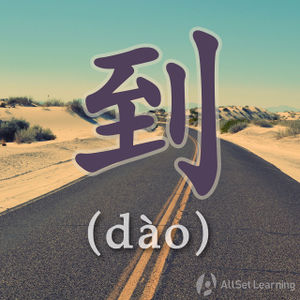Result complements "-dao" and "-jian"
-
Level
-
Similar to
-
Used for
-
Keywords
Two of the most common result complements in Chinese are 到 (dào) and 见 (jiàn). On this page we're only going to be talking about verbs related to the senses ("see," hear," etc.), and for this usage, the two are interchangeable.
Contents
Verb with "到" and "见"
Structure
Result complements are a huge topic in Chinese grammar, but you can approach them in stages. The structure you come across the most is a verb with 到 (dào):
Subject + Verb + 到 + Object
What 到 does is indicate that the outcome of the verb is achieved - what its result is. Without a result complement, the sentence would describe only the action itself. To illustrate, 看 "to look" is the action of turning one's head in a particular direction and focusing one's eyes, whereas 看到," to see," is the result of your brain taking in the visual input.
The complement 见 is very similar to 到, and it is used in the same way:
Subject + Verb + 见 + Object
However, there is a difference. 见 is generally only used after verbs involving sense, like 听 and 看, whereas 到 can be attached to a large variety of verbs (which we will discuss at a higher level on Tricky uses of "dao").
Examples
- 你 听 见 了 吗?Did you hear it?
- 你 听 到 了 吗?Did you hear it?
- 你 看 见 那 个 帅哥 了 吗?Did you see that handsome boy?
- 你 看 到 那 个 帅哥 了 吗?Did you see that handsome boy?
- 我 遇 见了 一 个 老 朋友。I met an old friend.
- 我 遇 到 了 一 个 老 朋友。I met an old friend.
Negative form
Structure
Subject + 没 + Verb + 到/见 + Object
As in the last sentence, this structure can be negated using 没.
Examples
- 你 没 听 见 吗?Did you hear it?
- 我 没 听 见。Did you hear it?
- 你 没 看 到 那 个 帅哥 吗?Did you see that handsome boy?
- 我 没 看 到 那 个 帅哥。Did you see that handsome boy?
- 我 没 遇 见老 朋友。I didn't meet my old friend.
- 我 没 遇 到老 朋友。I didn't meet my old friend.
See also
Sources and further reading
Books
- Short-term Spoken Chinese: Threshold Vol. 2 (汉语口语入门篇下) (pp. 92) →buy
- Basic Patterns of Chinese Grammar (pp. 109) →buy
- 40 Lessons for Basic Chinese Course (基础汉语40课上册) (pp. 205-6)→buy



